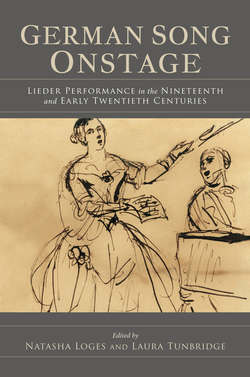Читать книгу German Song Onstage - Laura Tunbridge - Страница 11
На сайте Литреса книга снята с продажи.
Оглавление3From Miscellanies to Musical Works
Julius Stockhausen, Clara Schumann, and Dichterliebe
Natasha Loges
THE SONG CYCLE eludes definition. As John Daverio has eloquently argued, the genre “discloses a paradoxical movement between the artlessness, the noble simplicity demanded by the Lied tradition, and the artfulness that a cyclic form should display. … We expect that the Lieder in question will amount to more than a mere collection, that they will exhibit elements of musicopoetic cohesiveness extending beyond the individual Lied to encompass the entire set.”1
Several things can be inferred from this description. The first is well known, namely that the individual Lieder that collectively constitute a cycle occupy a nebulous aesthetic space that shifts between small-scale, accessible miniatures and high art, sometimes within the same song. The second—namely, the implication that a cycle is always apprehended as an unbroken whole, whether via a score, recording or performance—is worthy of pause, because, as I have shown elsewhere, this was certainly not the case for the early concert history of the song cycle, starting in the mid-nineteenth century.2 At that time, within the standard patterned miscellany concert format, cycles were frequently broken up, presented as subgroups of songs usually interspersed with instrumental works, or in smaller selections.3 A third, more implicit point in Daverio’s use of the words “we expect” is that expectations play a role in the perception of the cyclic qualities of a group of songs, or indeed, any collection of small pieces bearing such associations. Today, audiences (both scholarly and general) are conditioned to receive song cycles as continuous wholes, so the broken-up song cycle presents intriguing challenges to this inevitability. Most commentators have dismissed this substantial performance tradition as peculiar and outdated, a blip in the song cycle’s history that contravenes the composer’s planned coherence in an otherwise tidy teleology of wholeness.4 In this chapter, I will explore how the first public performers of song cycles helped shape the genre’s substantial and tenacious identity as it has coalesced in both performance and scholarship and how that identity was aligned with the instrumental work concept as defined by Lydia Goehr. I argue that such programs enabled audiences to attach the associations of serious instrumental music to song cycles.5 Programming is an overlooked part of the “framing, staging, and placement,” which Goehr has argued is a crucial way of communicating a work’s status to audiences.6 I will conclude by exploring some scholarly imperatives that have unwittingly encouraged the marginalization of this rich performance history.
My case study is seven public performances of Robert Schumann’s Dichterliebe, op. 48, given by the baritone Julius Stockhausen (1826–1906), the Lied’s “founding father,” with Clara Schumann.7 These concerts all took place in major German-speaking cities within a single decade, 1862–72. They were years of exploration and experimentation in the performance of song cycles in public; for example, Stockhausen had given the landmark first complete performance of Schubert’s Die schöne Müllerin, D795, in 1856, and the first Dichterliebe in 1861.8 He continued to perform cycles in various formats during the 1860s. In 1874, his post as director of Berlin’s Stern choral society slowed his recital activities.9 The period 1862–72 also aligns with a peak in Clara Schumann’s career, before personal tragedies and declining health severely curtailed her playing.10 Such performances laid the foundations for the subsequent “monumentalization of the canonized Lied” in the 1880s.11
